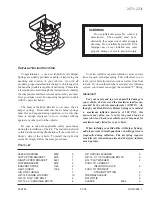
DRIVE (D): This position is for normal driving. If you
need more power for passing, and you are:
•
Going less than about 35 mph (55 km/h), push your
accelerator pedal about halfway down.
•
Going about 35 mph (55 km/h) or more, push the
accelerator all the way down.
You will shift down to the next gear and have more
power.
DRIVE (D) can be used when towing a trailer, carrying
a heavy load, driving on steep hills or for off-road
driving. You may want to shift the transmission to
THIRD (3) or, if necessary, a lower gear selection if the
transmission shifts too often.
THIRD (3): This position is also used for normal driving,
however it offers more power and lower fuel economy
than DRIVE (D).
SECOND (2): This position gives you more power but
lower fuel economy. You can use SECOND (2) on
hills. It can help control your speed as you go down
steep mountain roads, but then you would also want to
use your brakes off and on.
If you manually select SECOND (2), the transmission
will drive in second gear. You may use this feature
for reducing the speed of the rear wheels when you are
trying to start your vehicle from a stop on slippery
road surfaces. Once the vehicle is moving, shift into
DRIVE (D).
FIRST (1): This position gives you even more power,
but lower fuel economy than SECOND (2). You can use
it on very steep hills, or in deep snow or mud. If the
shift lever is put in FIRST (1) while the vehicle is moving
forward, the vehicle will not shift into first gear until
the vehicle is going slowly enough.
Notice: Spinning the tires or holding the vehicle in
one place on a hill using only the accelerator
pedal may damage the transmission. If you are
stuck, do not spin the tires. When stopping on a hill,
use the brakes to hold the vehicle in place.
On cold days, approximately 32°F (0°C) or colder, your
transmission is designed to shift differently until the
engine reaches normal operating temperature. This is
intended to improve heater performance.
2-21
Summary of Contents for Sierra Denali 2006
Page 5: ...These are some examples of symbols that may be found on the vehicle v...
Page 6: ...NOTES vi...
Page 114: ...NOTES 2 46...
Page 117: ...NOTES 3 3...
Page 118: ...Instrument Panel Overview 3 4...
Page 216: ...NOTES 3 102...
Page 280: ...NOTES 4 64...
Page 359: ...4 Remove all the wheel nuts and take off the flat tire Rear Position 5 79...
Page 361: ...Front Position Rear Position 5 81...
Page 386: ...5 106...
















































